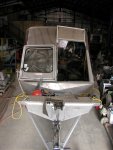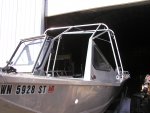StarTed
Senior Chief Petty Officer
- Joined
- Jul 14, 2015
- Messages
- 694
I'm having trouble keeping my trolling motor batteries charged up, especially when out on the water for more than 1 day with no or not enough power to recharge the batteries. As a result I'm planning to install a couple of solar panels on top of my boat. I built an aluminum canopy to replace the bimini top that was shot.
The panels I ordered are 210 watts from Continuous Resources and will need to be connected in series for the 24 volts needed for the batteries. I would have gone with a 36 volt system but an extra battery would take up too much space.
The size of each panel is around 59 X 27 inches. These panels are capable of putting out almost 10 amps each. Wiring them separately for 12 volts for each battery would require 2 controllers so I'm opting for a series arrangement.
I have some questions and concerns.
How do I mount these solar panels so the shocks from cruising won't damage them?
I'm thinking of making up some kind of folding arrangement so I can fold them over each other with the solar surfaces facing each other. That way the top panel will be upside down with cushioning along the edges. Will it be strong enough that way?
My top is 48" wide before it begins curving and the back flat area is around 35". I expect one panel to hang back over the top when in use but not while travelling down the road if I use a hinged arrangement.
Does anyone have any experience doing something like this?
Thanks in advance.
The panels I ordered are 210 watts from Continuous Resources and will need to be connected in series for the 24 volts needed for the batteries. I would have gone with a 36 volt system but an extra battery would take up too much space.
The size of each panel is around 59 X 27 inches. These panels are capable of putting out almost 10 amps each. Wiring them separately for 12 volts for each battery would require 2 controllers so I'm opting for a series arrangement.
I have some questions and concerns.
How do I mount these solar panels so the shocks from cruising won't damage them?
I'm thinking of making up some kind of folding arrangement so I can fold them over each other with the solar surfaces facing each other. That way the top panel will be upside down with cushioning along the edges. Will it be strong enough that way?
My top is 48" wide before it begins curving and the back flat area is around 35". I expect one panel to hang back over the top when in use but not while travelling down the road if I use a hinged arrangement.
Does anyone have any experience doing something like this?
Thanks in advance.























